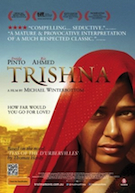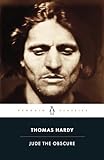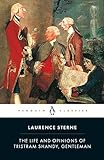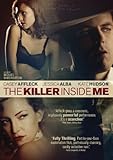 When it comes to adapting serious fiction for the screen, John Huston has few peers. But the English director Michael Winterbottom continues to burnish his reputation as a master of this maddeningly slippery art at this year’s Tribeca Film Festival, which is featuring the American premiere of Trishna, Winterbottom’s daring re-imagining of the Thomas Hardy novel Tess of the D’Urbervilles. Today, by way of exploring the difficulty of transporting stories from page to screen, we’ll look at three Winterbottom adaptations of three very different novels from three different centuries.
When it comes to adapting serious fiction for the screen, John Huston has few peers. But the English director Michael Winterbottom continues to burnish his reputation as a master of this maddeningly slippery art at this year’s Tribeca Film Festival, which is featuring the American premiere of Trishna, Winterbottom’s daring re-imagining of the Thomas Hardy novel Tess of the D’Urbervilles. Today, by way of exploring the difficulty of transporting stories from page to screen, we’ll look at three Winterbottom adaptations of three very different novels from three different centuries.
Thomas Hardy’s Tess of the D’Urbervilles

 Trishna is not Winterbottom’s first foray into Hardy’s fiction, nor the first time he has lifted Hardy’s characters from fictional Wessex and plunked them down in a faraway place. Winterbottom adapted Hardy’s most controversial novel, Jude the Obscure, in 1996, and followed it four years later with The Claim, a retelling of The Mayor of Casterbridge set in California’s Sierra Nevada mountains during the gold rush.
Trishna is not Winterbottom’s first foray into Hardy’s fiction, nor the first time he has lifted Hardy’s characters from fictional Wessex and plunked them down in a faraway place. Winterbottom adapted Hardy’s most controversial novel, Jude the Obscure, in 1996, and followed it four years later with The Claim, a retelling of The Mayor of Casterbridge set in California’s Sierra Nevada mountains during the gold rush.
But Trishna, set in contemporary India, is by far Winterbottom’s most daring – and successful – adaptation of Hardy. The conventional reading of Hardy is that he was a forward-thinker who railed against the two most confining straitjackets of life in Victorian England: the pressure to conform to social conventions and the stark boundaries imposed by class and gender. Winterbottom offers a much subtler reading. As he told The Guardian recently by way of explaining his decision to set Trishna (and, he might have added, The Claim) far from England: “Hardy’s novels are often about modernity and speed and energy. But it’s hard to get that sense of a dynamically changing world if you set one in this country [England]. Here the problems are more to do with a lack of mobility rather than an excess of it.”
That’s smart, but it carries a risk. While contemporary India offers an abundance of photogenic modernity, speed, and energy, it is also a gargantuan cliche: the gaudy colors, the cows, the slums and traffic and noise and dirt, those nearly visible smells. It’s worth remembering that two of the biggest international hits to come out of India recently, Slumdog Millionaire and Darjeeling Limited, were avalanches of these very cliches.
Winterbottom, who also wrote the screenplay, avoids this trap by streamlining Hardy’s story and using the frenzied urbanization and changing class structure of contemporary India as tools to tell his story, never as mere eye candy. The title character is played by Freida Pinto (who had her breakout in Slumdog Millionaire), a poor girl in the rural northwestern state of Rajasthan who catches the eye of a wealthy hotel owner named Jay (Riz Ahmed) when he passes through her town with a freewheeling gang of rich tourists. Smitten, Jay offers Trishna a job at his hotel in the capital city of Jaipur, which her family pushes her to accept. Inevitably, a romance will bloom.
A composite of the novel’s two love interests, Alec d’Urberville and Angel Clare, Jay spirals from seduction to genuine love to fatal cruelty after the lovers move to Mumbai. There are other deft echoes of the novel. Instead of giving birth to her illegitimate child and losing it to illness, as happened to Tess, Trishna deals with an unwanted pregnancy by having an abortion. And in a moment of extreme need, Trishna goes to work in a dehumanizing food-packaging factory, just as Tess was nearly crushed by a ravenous new invention called the threshing machine. Hardy’s fiction, as Winterbottom noted, was suffused with the tension in an urbanizing society – the seduction of modern inventions even as they brutally obliterate old ways. A rural English train depot perfectly captures this tension. It is, Hardy writes, a place where “a fitful white streak of steam at intervals upon the dark-green background denoted intermittent moments of contact between their secluded world and modern life. Modern life stretched out its steam feeler to this point three or four times a day, touched the native existences, and quickly withdrew its feeler again, as if what it touched had been uncongenial.”
By bringing this tension to life in contemporary India, Winterbottom has captured the spirit of Hardy’s novel without being slavish to its letter. As a result, the movie manages the difficult trick of being both faithful and new, less a reproduction than a rich act of re-imagining.

 Laurence Sterne’s Tristram Shandy
Laurence Sterne’s Tristram Shandy
If ever a work of literature deserved to be called “unfilmable,” The Life and Opinions of Tristram Shandy, Gentleman is surely it. Laurence Sterne’s great bawdy romp of a novel – a man named Tristram Shandy is talking to the reader about the story of his life he is trying to write as he writes it – is so disheveled, so plotless, so self-referential, so sprawling and messy and repetitive and hilarious that it almost dares a filmmaker to take a whack at it.
 For his 2005 adaptation, which he called Tristram Shandy: A Cock and Bull Story, Winterbottom worked from a screenplay by Frank Cottrell Boyce, who also wrote the scripts for Winterbottom’s The Claim, 24 Hour Party People, and Code 46. This time out, Boyce cleverly solves the conundrum of the source material by turning it on its head: if Sterne wrote a book about writing a book, then let’s make a movie about making a movie about that book. The cast is led by two more Winterbottom regulars – Steve Coogan playing himself playing Tristram Shandy and Rob Brydon playing himself playing Tristram’s uncle Toby.
For his 2005 adaptation, which he called Tristram Shandy: A Cock and Bull Story, Winterbottom worked from a screenplay by Frank Cottrell Boyce, who also wrote the scripts for Winterbottom’s The Claim, 24 Hour Party People, and Code 46. This time out, Boyce cleverly solves the conundrum of the source material by turning it on its head: if Sterne wrote a book about writing a book, then let’s make a movie about making a movie about that book. The cast is led by two more Winterbottom regulars – Steve Coogan playing himself playing Tristram Shandy and Rob Brydon playing himself playing Tristram’s uncle Toby.
The movie they’re fitfully making is at times surprisingly faithful to Sterne’s novel. We get Tristram’s botched conception, his botched birth, his botched nose, his botched, nearly disastrous circumcision. Also, as in the novel, we get countless throwaway lines, such as when Coogan tries to gently fend off the advances of a horny crew member with this left-handed compliment: “Your knowledge of German cinema is second to none.” There are snide swipes at Kevin Costner’s interpretation of Robin Hood and a moment when Coogan looks at a copy of Sterne’s novel and marvels, “Can you believe that a book as thick as that doesn’t have an index?” But the best of the lot is when Coogan, who knows how movie stars act and who obviously hasn’t read the novel, describes it to an interviewer as “a post-modern classic written way before there was any modern to be ‘post’ about.” Sterne surely would have approved. After all, he offers this defense of his tendency to digress, to talk to the reader, to leave pages blank, to write chapters out of chronological order and otherwise break every rule of conventional novel-writing: “All I wish is, that it may be a lesson to the world, ‘to let people tell their stories their own way.'”
While spoken in jest, Coogan’s remark about “post-modern classic” backs up my beliefs that this 18th-century novel is indeed one of the earliest exercises in post-modernism, that Don Quixote was the first, and that Flann O’Brien, not Joyce or Beckett, was the 20th century’s first practitioner of the form. In other words, the novelist’s willingness to expose the creative process, play structural tricks and be shamelessly self-aware was not an invention of the 20th century. Virginia Woolf believed Sterne “is singularly of our own age” and “the forerunner of the moderns,” while Italo Calvino anointed Tristram Shandy as “undoubtedly the progenitor of all avant-garde novels of our century.”
Along with the David Cronenberg’s adaptation of Naked Lunch and Terry Gilliam’s Fear and Loathing in Las Vegas, I say Winterbottom’s brilliant Tristram Shandy is final proof that the overused word “unfilmable” should be banished from the lexicon.
 Jim Thompson’s The Killer Inside Me
Jim Thompson’s The Killer Inside Me
Jim Thompson’s noir novels and stories have been turned into more than a dozen movies. Most filmmakers have latched onto the obvious cinematic allures of Thompson’s fiction – the intricate plots, the stunning double-crosses, the lavish violence – while shying away from what goes on in the dark recesses of the human mind, which is where Thompson did his real work. Maybe this is to be expected since fiction has an unfair advantage over film in this regard. It isn’t forced to rely so heavily on images; it’s freer to explore interiority; it is, in a word, more psychological. Just the sort of material for a filmmaker as smart and literary as Michael Winterbottom. And yet, this time he stumbles.
 In 2010 Winterbottom directed a second version of Thompson’s breakthrough 1952 novel, The Killer Inside Me. The first version, a half-baked disaster directed by Burt Kennedy and starring Stacey Keach, came out in 1976. While Kennedy and his screenwriters, Edward Mann and Robert Chamblee, blithely butchered Thompson’s novel, Winterbottom and his screenwriter, John Curran, remain almost slavishly faithful to the text. It’s a lesser sin, but still a sin and not at all characteristic of Winterbottom, as we have seen. It’s hard to tell if he was suffering from a surfeit of reverence or a rare failure of imagination and will. But what’s on the screen is far too literal – more transcript than interpretation, more homage than distinctive work of art. As a result, the movie feels frozen in amber, oddly lifeless considering what the characters are doing to each other on the screen.
In 2010 Winterbottom directed a second version of Thompson’s breakthrough 1952 novel, The Killer Inside Me. The first version, a half-baked disaster directed by Burt Kennedy and starring Stacey Keach, came out in 1976. While Kennedy and his screenwriters, Edward Mann and Robert Chamblee, blithely butchered Thompson’s novel, Winterbottom and his screenwriter, John Curran, remain almost slavishly faithful to the text. It’s a lesser sin, but still a sin and not at all characteristic of Winterbottom, as we have seen. It’s hard to tell if he was suffering from a surfeit of reverence or a rare failure of imagination and will. But what’s on the screen is far too literal – more transcript than interpretation, more homage than distinctive work of art. As a result, the movie feels frozen in amber, oddly lifeless considering what the characters are doing to each other on the screen.
As the story unfolds, we learn that a small-town Texas deputy sheriff named Lou Ford is fighting not to have a relapse of “the sickness,” an adolescent sexual fascination with little girls that morphed into a scandalous, violent liaison with a much older woman. Lou’s step-brother took the fall for Lou years ago and ended up getting murdered for it. Lou has waited six years to get back at the killer, the construction tycoon Chester Conway, because he understands that revenge is a dish best served cold. He’ll exact his by murdering his prostitute lover, then luring Conway’s son to the scene and shooting him, making the mess look like a double murder between illicit lovers. The Conway family name will be ruined. We’re deep in Jim Thompson country here: the novel is less a straight crime yarn than an unflinching tour of a sick mind.
Lou Ford himself serves as tour guide, speaking in the first person to the reader in a voice that gives new meaning to the word unreliable. Sometimes he stands in for Thompson, who enjoyed his first big success with this novel but never apologized for his lack of highbrow aspirations. Here’s Lou Ford delivering a very Thompson-esque piece of literary theory:
In a lot of books I read, the writer seems to go haywire every time he reaches a high point. He’ll start leaving out punctuation and running his words together and babble about stars flashing and sinking into a deep dreamless sea. And you can’t figure out whether the hero’s laying his girl or a cornerstone. I guess that kind of crap is supposed to be pretty deep stuff – a lot of book reviewers eat it up, I notice. But the way I see it, the writer is just too goddam lazy to do his job. And I’m not lazy, whatever else I am. I’ll tell you everything.
Atmosphere is critical in any noir, and Winterbottom tries to capture the novel’s moral aridity through verbatim dialog and voice-overs from the novel, but it never quite gels. Much more successful at capturing atmosphere is the movie’s cinematography – those bleached colors, stark stretches of desert, and brooding mountains. It’s an extreme place where extreme things seem almost destined to happen. Another strong point is a killer soundtrack that includes works ranging from Enrico Caruso and Gustav Mahler to Hank Williams, Charlie Feathers, and the Western swing fiddler Spade Cooley. (Cooley, in an apt twist for these surroundings, was convicted of beating his wife to death in 1961.)
Best of all is the cast. Elias Koteas, who always looks like he was just dipped in dirty motor oil, plays a deliciously smarmy union boss. Ned Beatty is serviceable as the porcine tycoon. Bill Pullman has a nice little cameo as an unhinged defense attorney. Jessica Alba as the doomed hooker and Kate Hudson as Lou’s doomed fiancee both do fine jobs of living hot and dying (or appearing to die) hard. But the key gear in the works is Casey Affleck’s deadpan portrayal of Lou Ford. His smooth cheeks, lidded eyes, monotone drawl. and correct manners are a mask, his way of convincing the world he’s decent and a little slow, no threat to anyone. Affleck is not capturing the banality of evil; he’s uncovering the evil that can hide behind blandness. He did the same thing in The Assassination of Jesse James by the Coward Robert Ford. This is true creepiness, and true art.
So creepy that Lou is capable of beating two women to death with his bare hands while murmuring, “I’m real sorry…I love you…goodbye.” Many viewers and critics had a hard time watching this graphic violence, which begs the question: Is domestic violence supposed to look pretty? Only if you’re in the fetishistically stylized world of a Guy Ritchie or Quentin Tarantino movie, where getting your head blown off can look so cool. Thompson – and Winterbottom – are making the point that such violence is both horrible and horrible to look at, and, what’s way worse and way more important, there’s a bit of Lou Ford inside every one of us. The only person who doesn’t get this is Lou Ford. He believes, rightly, that he’s sick, but he also believes, wrongly, that this sets him apart from the rest of humanity, that he’s one of the evil “us” who live in the midst of the sane and good “them.” As Lou puts it, “If the Good Lord made a mistake in us people it was in making us want to live when we’ve got the least excuse for it.” Later he adds, “Our kind. Us people. All of us that started the game with a crooked cue, that wanted so much and got so little, that meant so good and did so bad.”
Winterbottom’s portrayals of violence in this movie have been called everything from “misogynistic” to “feminist.” They’re neither. They’re valid artistic representations of an abiding fact of human life, especially when the humans are damaged goods. Thompson and Winterbottom never exalt Lou Ford or other monstrous characters, the way, say, Oliver Stone did in the execrable Natural Born Killers. I watched The Killer Inside Me with a friend who is a staunch opponent of the Guantanamo Bay prison and the death penalty. Unable to watch Lou Ford beat a second woman’s face into hamburger, my friend muttered, “I’d like to torture that sonofabitch to a slow death.” Then she stormed out, halfway through the movie. I took her revulsion to be a barometer of Thompson’s and Winterbottom’s success. They loosed my friend’s monstrous yearning to torture and kill the monstrous Lou Ford. In doing so they proved that there is, indeed, a bit of Lou Ford in all of us.
It wasn’t until I’d re-read all three novels and watched Winterbottom’s adaptations that I came to understand what ties these three movies together and what sets them apart. First, of course, they were all directed by a man with a high literary sensibility who is a master at casting actors and drawing quality performances out of them. Production values are uniformly high. Marcel Zyskind served as cinematographer on all three films, giving each a look appropriate to the story’s mood and message.
Then came the realization why these movies are so uneven: each had a different screenwriter. In Trishna, Winterbottom’s script shrewdly updates a story about a rural society’s traumatic urbanization; Boyce’s script of Tristram Shandy perfectly captures the antic, self-referential spirit of its source material; and The Killer Inside Me falls flat because Curran’s script treats Thompson’s novel as a blueprint rather than a springboard.
In other words, the hardware of a movie – its direction, acting, cinematography, editing, makeup, music. and wardrobe – can carry it only so far. It turns out that in movies just as much as in books, the writing is, always and forever, the thing.









